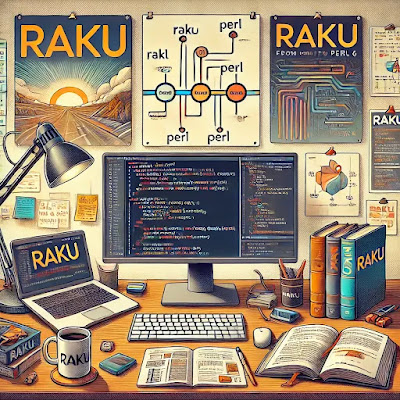Introduction to Raku: The Evolution of Perl 6
In the world of programming, languages evolve, communities shift, and sometimes, a new identity is born from the seeds of the old. Such is the case with Raku, formerly known as Perl 6. This blog post delves into the reasons behind the rebranding of Perl 6 to Raku, exploring the historical context, the implications for the programming community, and what this means for developers who use these languages.
The Genesis of Perl 6
Perl, since its inception in 1987 by Larry Wall, has been a powerhouse in the scripting language community, known for its text processing capabilities and its pivotal role in the early web development scene. Perl 5, released in 1994, became synonymous with CGI scripting and played a significant role in server-side programming.
Perl 6 was envisioned as a successor to Perl 5, an ambitious overhaul aimed at addressing the shortcomings and modernizing the language. It introduced features like grammars for parsing, a powerful type system, and concurrent and functional programming capabilities. However, Perl 6 was not just an update but a complete rewrite that took nearly two decades of development before reaching a stable release.
Why the Rename to Raku?
1. Differentiation from Perl 5
One of the primary reasons for renaming Perl 6 to Raku was to differentiate it clearly from Perl 5. Despite the numerical succession, Perl 6 is fundamentally different from its predecessor in syntax and features. The community needed to clarify that the two are distinct languages, suitable for different purposes and not merely different versions of the same tool.
2. Community Decision
The renaming process was community-driven. Larry Wall, the creator of Perl, proposed the name Raku, inspired by the Japanese word for ‘comfort’ or ‘ease,’ reflecting the language’s design philosophy. This change was ratified through a voting process in the Perl and Raku communities, demonstrating a democratic approach to significant decisions.
3. Marketing and Branding
Raku’s new identity helps in rebranding the language for new audiences. This separation from Perl can reduce confusion for new developers and helps position Raku as a modern, robust, and versatile language in its own right. The rebranding is also a strategic move to rejuvenate the language’s image and attract developers who might have preconceived notions about Perl’s complexity and outdatedness.
Implications for Developers
For existing Perl developers, the change signifies a need to adjust perceptions and possibly adopt or transition to Raku if they are looking for features that are markedly advanced compared to Perl 5. For new developers, Raku offers an enticing array of modern programming features without the baggage of Perl’s history.
Transitioning to Raku
Transitioning from Perl to Raku involves understanding the new syntax and features. However, Raku is designed to be more intuitive and has excellent documentation and community support to help new users.
Tooling and Ecosystem
The ecosystem around Raku is vibrant and growing. There are modules available for various tasks, and tooling support is strong with editors and IDEs offering support for Raku.
The rebranding of Perl 6 to Raku marks a new chapter in the life of this innovative language. It’s more than a name change; it’s a redefinition of the language’s identity and purpose in the broader landscape of programming languages. Whether you are an existing Perl programmer or a developer looking to pick up a new and exciting language, Raku offers a rich set of features and a welcoming community. As the Raku community says, “Raku continues to bend the Perl 6 vision.”


0 Comments:
Post a Comment
Note: only a member of this blog may post a comment.
<< Home